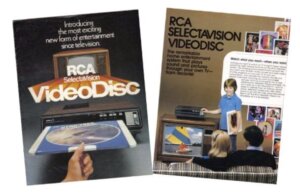We have extended the dates (and added a public tour) of our Vinyl Videos: The Rise and Fall of the RCA Videodisc exhibit!
 That’s right: Vinyl Videos, the Sarnoff’s in-depth look at the complicated story of the SelectaVision Videodisc system, RCA’s last large-scale research-driven commercial product, will be on view until the end of April. We’ve expanded the show’s overall footprint, added additional artifacts including more videodiscs available to play, and incorporated a high-powered microscope allowing close-up views of the technology at the heart of a system that turned out to be the epitome of analog record technology.
That’s right: Vinyl Videos, the Sarnoff’s in-depth look at the complicated story of the SelectaVision Videodisc system, RCA’s last large-scale research-driven commercial product, will be on view until the end of April. We’ve expanded the show’s overall footprint, added additional artifacts including more videodiscs available to play, and incorporated a high-powered microscope allowing close-up views of the technology at the heart of a system that turned out to be the epitome of analog record technology.
The Vinyl Videos exhibit tour for general audiences is scheduled for Sunday April 30 at 1pm: whether you directly recall this early-80s home video phenomenon, are a fan of vintage technologies, or love the layered cultural references inherent in a system that promised the home user access to a 50-year library of film and television programming, you will see, hear, and have the chance to share interesting stories.

The impetus for Vinyl Videos was the 2018 donation to the Sarnoff of a large group of artifacts and documents by the family of senior RCA videodisc project manager Dr. Jay Brandinger. This donation spanned technical mockups and research papers, administrative memos and public relations communications, even gifts, cartoons, and mementos marking contributions to the many aspects of this complicated project. Once added to the permanent collection, these materials, along with previously-donated pieces including videodisc patents, players, parts, and discs, represented a critical mass of embodied information (if that’s not too abstract a term) that offered the opportunity to tell multiple stories about the genesis, and the fate, of a project that can be traced back as far as 1964, and connects directly to the bankruptcy and breakup of RCA.
*
Let us take a step back before returning to the immediate effect that Vinyl Videos is having on the Sarnoff collection. It is arguable that these accumulated videodisc objects (indeed all the objects in this or any museum collection) represent a mandate more than a mere chance to tell the stories they represent. And there are multiple stories — and there are varied perspectives on each of these stories. Putting aside complaints that history should (or could) focus only on dates or facts, it seems clear that, from the recognition that history is largely told by the winners to the acknowledgment that any singular historical narrative presumes a homogenous audience for that narrative, no intellectually sound version of history can ignore this proliferation of points of view. Is it not arguable that, far from problematic, this ever-broadening diversity of interpretations reflects the state of the cultures making, writing, and responding to these stories?
Getting back to specifics, the impact of this inclusive approach to history can be best appreciated by looking at three categories of material added to the Sarnoff collection as a result of the Vinyl Videos exhibit. First, several individuals, including contributors to the original project have donated key videodisc-related artifacts to the permanent collection. Next, several other people have donated items to a separately-administered collection of spares and duplicates: while the permanent collection must be just that — permanent; preserved; protected — it is important to support behind the scenes, hands-on technical research, and front facing, and often interactive, exhibit components such as the operable SelectaVision player available to visitors in Vinyl Videos. Last, the exhibit has been informed by, and prompted the additional gathering of, oral histories that capture the recollections of participants in the original program. Six new interviews join two existing recordings for a total of nearly 20 hours of unique insights into the challenges, breakthroughs, gratifications, frustrations, and realizations that are part of any effort to work with other people to achieve something new.
*
The Sarnoff is working to make excerpts from these interviews available online and to create an online version of the entire Vinyl Videos exhibit. Meanwhile, we will be providing occasional links to vintage and more recent video content pertaining to the RCA SelectaVision videodisc project. Here are two:
A new-to-us YouTuber, Applied Science, shows, with a quiet competence that we find strikes just the right note in today’s busy world, how to create stop-motion views of various recording media via electron microscope. Applied Science probably knows that the electron microscope was developed at RCA; he just didn’t need to flex that knowledge. We’ve linked to the videodisc section but encourage you to watch the entire video, entitled Electron microscope slow-motion video of vinyl LP.
And…without comment, a gem from 1983.

